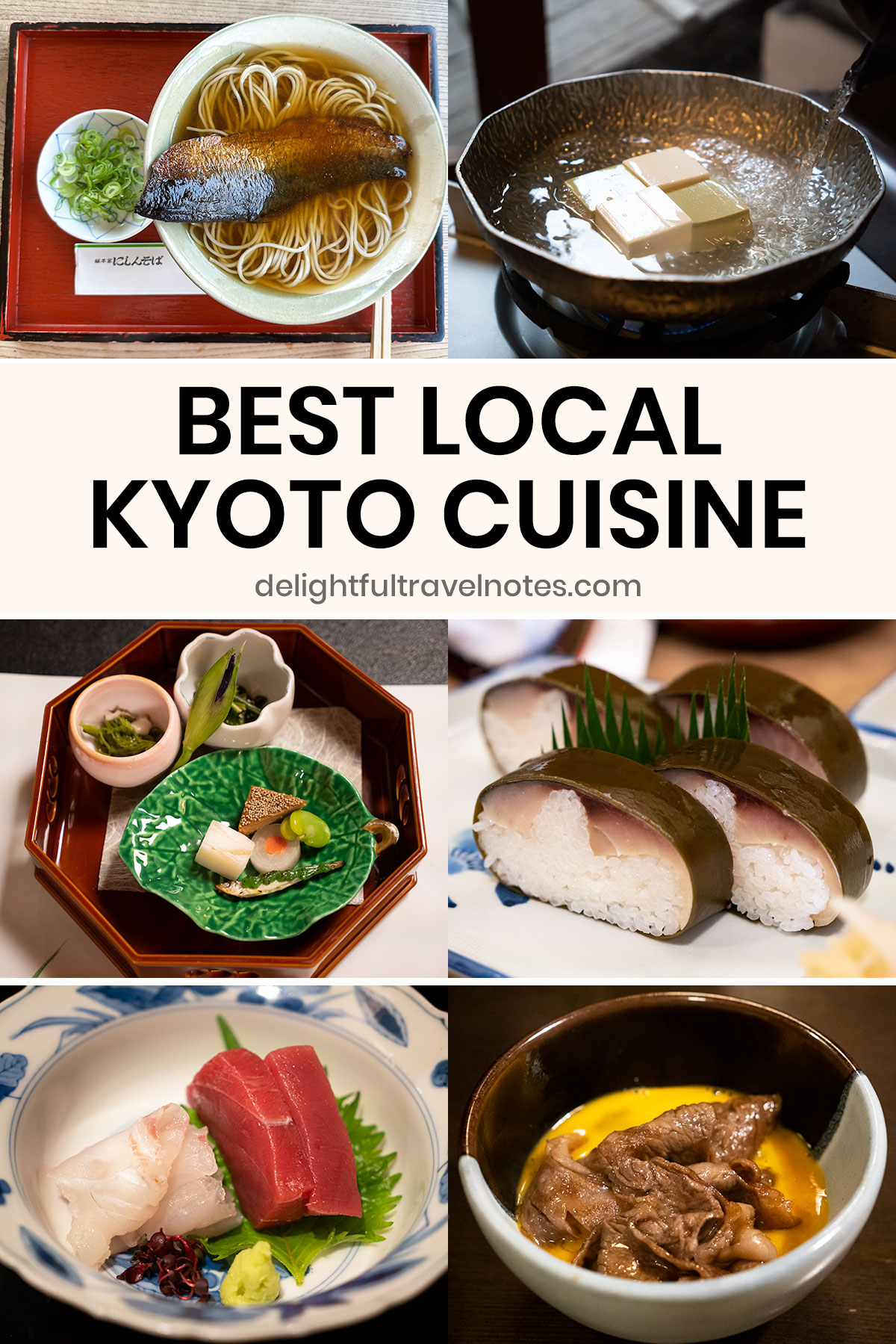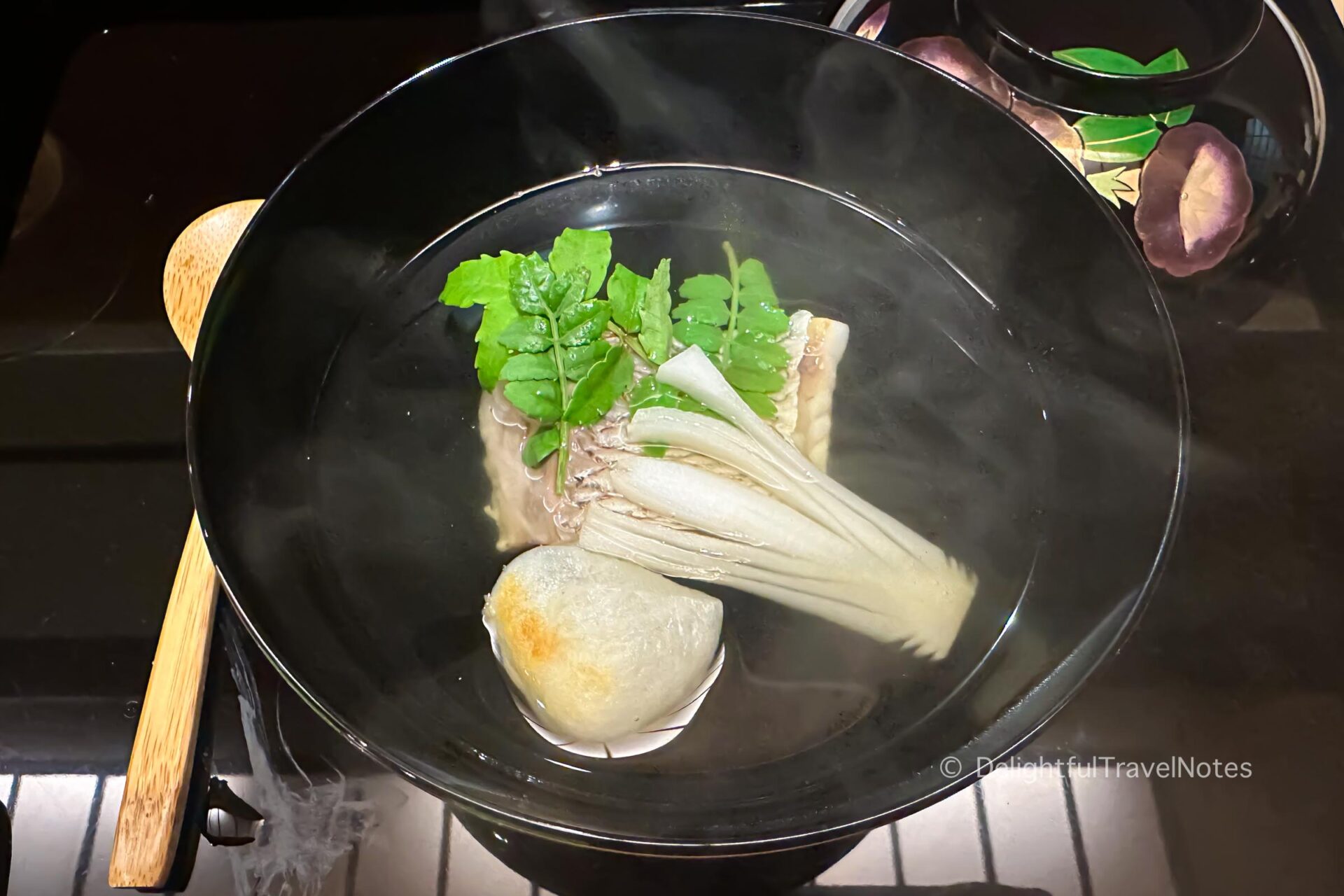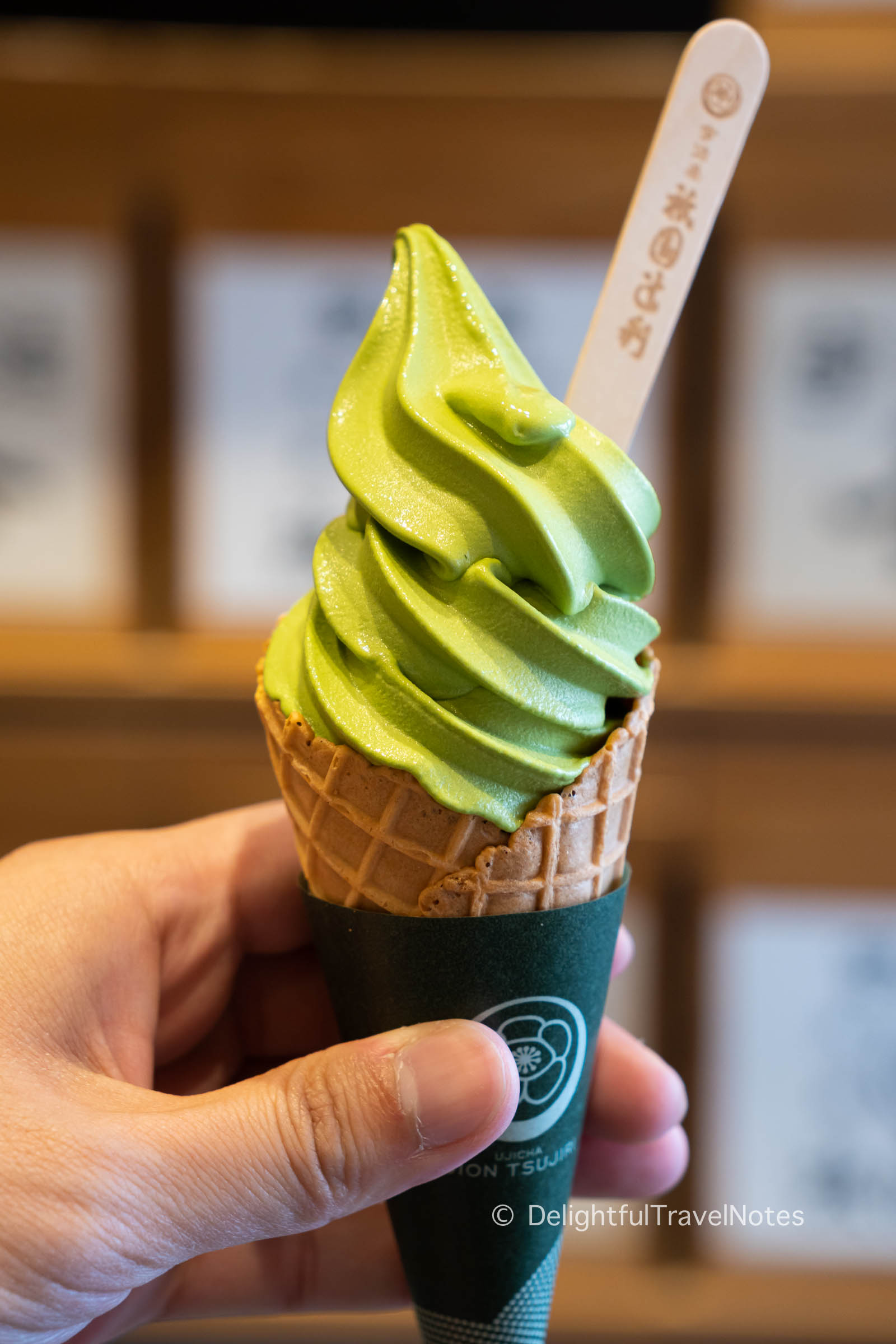Explore Kyoto Cuisine: Top Local Foods and Restaurants to Try
The cuisine of Kyoto is a reflection of the city’s rich cultural heritage, seasonal rhythms, and its high regard for balance and subtlety. You will find the list of must-try local Kyoto specialties along with where to eat them in this guide. The food of Kyoto is sure to make your trip more memorable.

Though we are pretty familiar with Japanese food, cooking it at home a few times a week as well as dining out, Kyoto cuisine still surprised us with its lightness and understated elegance. What we love about it is it favors a delicate balance that allows the natural taste of the ingredients to shine through. A dish isn’t likely to be overly sweet or excessively salty, unlike some other regional Japanese cuisines.
Take tamagoyaki, a simple Japanese rolled omelet dish, as an example. We have eaten it a number of times and aren’t really big fans since it is often quite sweet. Trying tamagoyaki in Kyoto totally changed our opinion. While in some parts of Japan (and outside of Japan), tamagoyaki is made quite sweet with the addition of sugar, Kyoto’s version is often prepared simply with eggs and dashi. This results in a tamagoyaki that is subtly savory, allowing the fresh, rich flavor of the eggs and umami of dashi to take center stage.
Kyoto’s culinary philosophy aligns with the principle of washoku, which emphasizes harmony and balance in a meal. As we explored Kyoto specialties, we felt that part of Kyoto’s history, its connection with nature, and its cultural traditions were conveyed through the food. A lot of restaurants in the city have been around for many decades.
We hope with our Kyoto food guide, you will set aside time in your trip to enjoy the delicious food of this city. The list will include best local foods and where to eat them in Kyoto. You may also want to check out how to spend four days in Kyoto.
Kaiseki
Kaiseki is the term for Japan’s multiple-course meal (usually 7-8 or more courses) featuring seasonal and regional ingredients. Each dish is thoughtfully prepared and beautifully presented, demonstrating the chef’s attention to balance, texture, appearance, and color. Ingredients and cooking methods are often not repeated among courses.

An important part of the Kaiseki experience is suimono, a clear soup course, traditionally served in a beautiful lacquer bowl. Of all the kaiseki meals we had, suimono was always the highlight.
Kyoto Kaiseki Restaurant Recommendations
In Kyoto, Kikunoi is among the best kaiseki restaurants. For an affordable Kyoto kaiseki meal, we recommend Hanasaki Manjiro, which is located in a quiet area of Higashiyama and near Yasaka Shrine. With just 6,000-8,000 yen, you can enjoy a delicious kaiseki dinner here. Reservation can be easily made online. Here is our detailed review of Hanasaki Manjiro with overview and photos of each course.
Kaiseki is served in separate dining rooms. If you like to have Japanese course meals while sitting at the counter observing the chefs, try kappo restaurants. We had a great lunch at Hassun for 11,000 yen while dinner would cost double that and likely serve more premium ingredients. Reservation is required, and our hotel concierge at the Celestine Gion helped us with the booking.

Hassun has a very high rating on Tabelog and currently has one Michelin star. The ingredients were of high quality and each dish displayed perfect execution and refined taste. The akami in the sashimi course was the best akami we tried in our trip. It was very lean and tender with a clean and mildly sweet taste. The suimono with fish fillet and toasted mochi was also exquisite. You can read more about the meal in our review of Hassun restaurant.

Mackerel Sushi (Sabazushi)
Kyoto mackerel sushi is a form of oshi-zushi (meaning “pressed sushi”) which features vinegared rice packed into a mold and covered with marinated fish. Oshi-zushi originated in Kansai area, and in the past, Kyoto’s inland location posed a challenge for transporting and enjoying raw fish.
The mackerel had to be preserved for the journey by using salt and vinegar marination. Then it is laid atop sushi rice and then wrapped in a thin sheet of kelp.
Best Kyoto Mackerel Sushi
To experience this unique style of sushi, visit Izuu, a restaurant famous for its mackerel sushi in Kyoto and highly recommended by the locals. The mackerel was so meaty and fatty, balanced by the tanginess of vinegar.

Izuu has only 4 tables, but fortunately we did not have to wait for a table when we came at 1pm on a weekday. Takeout is also available though. They have English translation for the menu and the staff were nice. Another place you can check out for sabazushi is Izuju.
Tofu and Yuba
Kyoto’s tofu and yuba cuisine is a prime example of the city’s dedication to simple, yet exquisitely refined cuisine. It is one of the Kyoto specialties you must try! The secret to Kyoto’s exceptional tofu lies in its water – the city is blessed with an abundant supply of soft water.
Tofu is often considered bland and is just a side dish. In Kyoto, it is celebrated in many forms, from yudofu (tofu hot pot) to more innovative uses like tofu-based sweets.

Yuba (tofu skin) is created by skimming off the thin layer that forms on the surface of soy milk as it heats. This ingredient, with its delicate texture and subtle nuttiness, is a staple in Kyoto cuisine. Yuba can be enjoyed in many ways: fresh, dried, fried, simmered, or added to soups and stews.

Best Kyoto Tofu Restaurants
We highly recommend trying a tofu meal when in Kyoto. You will find a number of tofu restaurants in Arashiyama and Western Higashiyama areas. Restaurants like Tofu Matsugae, Junsei, Tousuiro (2 locations: Gion and Nakagyo), Shoraian, and Yudofu Sagano offer dedicated tofu set meals, showcasing the versatility of tofu in a variety of dishes. Price for a course meal may range from 3,000-6,000 yen.
For Shoraian, reservation is a must. I haven’t tried Shoraian but I wasn’t impressed with Tousuiro. It is also recommended to reserve a table at Yudofu Sagano and Tofu Matsugae, but if you come early, there’s a high chance of getting a table with no wait. We enjoyed our very affordable tofu lunch set at Matsugae after exploring Arashiyama in the morning.

Herring Soba (Nishin Soba)
Nishin soba, a local specialty of Kyoto, perfectly reflects the city’s geography and historical context in a bowl. Soba, made from buckwheat, is found across Japan, but nishin soba sets itself apart by featuring a topping of dried herring, which is simmered in a sweet and savory sauce. This pairing of earthy, hearty soba noodles and flavorful herring results in an interesting dish unique to Kyoto.

Best Nishin Soba in Kyoto
We tried nishin soba at Matsuba, which has been around for over 100 years and is said to be where the dish was created decades ago. The restaurant also has other soba dishes on the menu and the price is very affordable.
Other highly-rated places you can try nishin soba are Yoshimura (Soba-no-mi Yoshimura and Arashiyama Yoshimura) and Honke Owariya. The Yoshimura soba branch in Arashiyama shares the same location with Matsugae Tofu.
Kansai-style Unagi
Unagi, or eel, is a delicacy savored throughout Japan, but the preparation and flavor profile can vary significantly between two regions, Kansai and Kanto. The primary difference lies in the cooking process.

Kanto-style unagi is first steamed then grilled, resulting in a soft texture. On the contrary, Kansai-style unagi, which is prevalent in Kyoto, forgoes the steaming process. The eel is grilled directly, typically over charcoal. This process imparts a smoky aroma to the eel, and by skipping the steaming process, the eel has a slightly firmer, yet succulent texture.
One bite of Kansai-style unagi in Kyoto was enough to make it our preferred style over Kanto-style. Its simplicity highlights the natural flavor, texture of the eel and the irresistible smoky aroma. If you go to Izuu for the mackerel sushi, I recommend trying their pressed unagi sushi as well.

There are a number of long-standing eel restaurants in Kyoto, such as Gion Uokeya U (reservation recommended) and Unagi Hirokawa. I quite liked our meal at Warajiya which included traditional grilled eel as well as some lesser known eel dishes. In case you can’t get a reservation or the line is too long, try the unadon in Takashimaya Kyoto depachika (basement food hall). We were surprised at how tasty it was.
Kansai-style Sukiyaki
Sukiyaki is a popular Japanese one-pot dish typically consisting of thinly sliced beef, tofu, vegetables like napa cabbage, enoki mushrooms, and noodles. Again, there are regional differences in the preparation method between Kanto and Kansai styles. And again, we found the Kansai-style more to our taste.
In Kanto-style sukiyaki, all ingredients are typically added to the pot at once and cooked together in a sweet and savory sauce/broth. On the other hand, Kansai-style sukiyaki begins by grilling the beef in the pot.

Then sugar and soy sauce are added directly to the pot to create the sauce, and the beef is simmered until it is coated in this sweet and savory mixture. Only then are the rest of the ingredients added to the pot, in stages based on their cooking times. This method allows the rich, meaty flavor of the beef to shine.
When in Kyoto, we recommend trying sukiyaki with high grade wagyu. It won’t be cheap but high quality beef really makes a difference. We had a sukiyaki dinner at Junidanya in Gion which was reserved online in advance and had a good time. Moritaya is also highly rated for sukiyaki.

Matcha + Desserts + Snacks
Don’t leave Kyoto without trying yatsuhashi, a traditional sweet made from rice flour, sugar, and cinnamon. This confectionery is filled with sweet red bean paste and can also come in various other flavors. We bought the original cinnamon flavor and matcha flavor at Izutsu Yatsuhashi (several locations in the city) and to our surprise, loved the cinnamon flavor more, even though we are a fan of everything matcha. Our friends loved the Godiva chocolate yatsuhashi we brought back.

Kyoto’s proximity to Uji, a region famous for its high-quality green tea, makes it a matcha paradise. There’s ice cream on almost every street in Gion, and we recommend the matcha soft serve at Tsujiri. Tsujiri also has a large selection of matcha, sencha, genmaicha, hojicha and matcha cookies. We loved everything we tried here and the place is so popular with the locals. These tea products are also great souvenirs to buy in Japan.

You can also check out Malebranche (several locations in Kyoto) which makes high quality matcha cookies as well as chocolate and sweets. We liked everything we sampled at their Gion shop. They also have a small booth selling several types of cookies at Kansai International Airport.
There are so many sweet and snack shops in Gion that we wished we could try them all. Another memorable one was a chestnut mochi we had on Sannenzaka on the way back from Kiyomizu-dera.
Conclusion
Have a wonderful time discovering and exploring Kyoto cuisine. You can also look into taking a guided foodie tour with a local. We hope every meal in Kyoto will enrich your understanding of this beautiful city and create memories that will linger long after the last bite. Feel free to let us know your favorite Kyoto foods and restaurants in the Comments section below. If you need more tips for visiting Kyoto, check out our guide on how to plan an amazing trip to Kyoto.
In case you want to read more about traditional Japanese cuisine and learn to cook it at home, I highly recommend the Japanese Cooking: A Simple Art cookbook. In my opinion, it is one of the best Japanese cookbooks written in English out there. Washoku: Recipes from the Japanese Home Kitchen is also a good book.




Explore More
Beautiful Fall Foliage Spots in Nara City
Shisui Hotel Review: Wonderful Stay Right Next To Nara Park
Hotel Setre Naramachi Review: Great Location for Sightseeing in Nara
One Comment